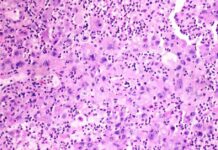Five Cases of Legionnaires’ Disease Reported in New Hampshire Downtown
Five individuals in downtown Lincoln, New Hampshire, have been diagnosed with Legionnaires’ disease, as announced by the New Hampshire Department of Health & Human Services (DHHS) in an August 12 press release. The affected individuals were likely exposed to contaminated water droplets from a cooling tower located behind the RiverWalk Resort, where tests confirmed the presence of Legionella bacteria in the water.
Dr. Benjamin Chan, New Hampshire state epidemiologist, advised that anyone who has visited the area near the contaminated cooling tower should monitor themselves for symptoms. He emphasized that individuals who develop fever or other pneumonia symptoms within 14 days after spending time in this area should seek testing for Legionella infection from their healthcare provider. The DHHS warned that those within a half-mile radius of the cooling tower could be at risk of exposure.
Legionnaires’ disease is a type of pneumonia caused by Legionella bacteria. While the bacteria is typically found in lakes, streams, and other freshwater environments, it can also grow and spread indoors through various water systems such as shower heads, sink faucets, hot tubs, and plumbing systems. When individuals swallow or breathe in droplets of water containing Legionella, they can become ill with Legionnaires’ disease. Although human transmission is rare, the disease is not commonly spread from person to person.
Dr. Nathan Goodyear, medical director of Brio-Medical in Arizona, highlighted that individuals at highest risk for Legionnaires’ disease include smokers, those with existing pulmonary disease, advancing age, cardiovascular disease, obesity, and compromised immune systems. Symptoms of the infection typically manifest between two and 14 days after exposure and may include cough, fever, shortness of breath, muscle aches, headaches, nausea, diarrhea, and confusion.
Early diagnosis of Legionnaires’ disease involves chest X-rays, urine tests, and lab analysis of phlegm samples. Treatment usually consists of a course of antibiotics, with some severe cases potentially leading to lung failure or death. Antibiotics such as Levofloxacin and Azithromycin are commonly prescribed for Legionella infection, with intravenous antibiotics often recommended for initial treatment due to the disease’s pathogenicity.
Preventing Legionnaires’ disease involves reducing the growth and spread of Legionella bacteria. The CDC recommends that building owners and managers implement water management programs to minimize the risk of infection. While there are currently no vaccines for Legionnaires’ disease, individuals can reduce their risk by quitting smoking, supporting chronic pulmonary disease, and boosting immune function through supplements like vitamin D3, Vitamin C, and Zinc.
Obesity is also identified as a key risk factor for chronic inflammatory diseases, including Legionnaires’ disease. By addressing lifestyle habits and enhancing immune support, individuals can take proactive steps to protect themselves against Legionella infection.
In conclusion, Legionnaires’ disease poses a serious health risk, particularly in environments where Legionella bacteria can thrive. By staying informed about the causes, symptoms, and prevention strategies, individuals can safeguard their health and take necessary precautions to minimize the spread of this potentially deadly illness.

















